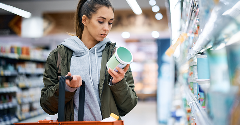News
COVID-19 may permanently change how we buy alcohol
21 May 2020Online sales of alcohol are skyrocketing due to restrictions on movement that inhibit consumers from enjoying their favorite cocktails outside the confines of their house and deter in-person trips to the supermarket. According to data from Nielsen, e-commerce booze sales are up 234% for the seven-week period ending April 18 as compared to last year. This continued growth makes the alcohol category the fastest growing e-commerce department among consumer packaged goods.
This data from Nielsen matches reports from e-commerce alcohol enterprises. Drizly reported its sales increased 392% over baseline for the week ending April 26th. Much of that increase was driven by new customers who comprised 27% of the total orders as compared to the usual proportion of 15%. Direct -to-consumer wine club, Winc, saw a 578% increase in new member sign-ups and a corresponding 29.6% increase in sales during the week ending March 21. Similarly, the online liquor service Minibar had its sales jump 160%.

Such a rapid and significant increase in alcohol sales will be a boon for a segment that’s been struggling. Beer volumes in the U.S. have declined for years and wine sales saw their first drop in 2019 after 25 years of growth. This improvement in sales could also translate into a turnaround for the industry if the pandemic drags on and online alcoholic beverage sales continue to gain steam.
Industry leaders like Drizly CEO Cory Rellas are predicting online alcohol sales to accelerate by as much as 8%, a 6% jump from today’s figures, reported The Wall Street Journal. This rise in orders could help ingrain the habit for consumers who are already used to the concept of online grocery purchasing but are still adjusting to the idea of e-commerce alcohol.
But direct to consumer is only one avenue through which demand for alcohol has increased. In the retail space, sales of spirits have seen the most pronounced growth (75%) followed by wine (66%) and then beer, malt beverages and cider (42%), according to data from Nielsen.
Forbes reported that tequila and gin were the biggest winners for the month seeing astronomical increases that mirror the libations’ growing popularity among consumers. On-demand grocery delivery service Instacart also saw its alcohol sales grow by 75% during March.
Although unfortunately named, Corona beer sales do not seem to have plummeted. Constellation Brands, the brew’s parent company, saw sales soar 50%.
Nielsen data estimates that the U.S. alcohol market will need to sustain 22% volume growth across all alcohol categories in order to compensate for the financial impact caused by the closure of bars and restaurants. Although sales have seemingly been catapulted into the stratosphere, only wine and spirits are pacing above this 22% volume growth threshold, according to Nielsen.
Related news

Value is a top priority for today’s F&B consumers
3 Apr 2025
Research from global consultancy Hartman Group suggests there are six core values that brands must tap into to connect with consumers’ needs.
Read more
Future F&B flavours favour exploration and explosive taste profiles
25 Mar 2025
Exploration and experimentation will define the future of flavour, according to Mintel, as consumers seek out taste profiles and textures that offer an adventurous eating experience.
Read more
Global consumers enjoy food less and perceive it as less healthy
20 Mar 2025
Enjoyment of food and its perceived healthiness is dwindling among most global populations, according to findings from Gallup and Ando Foundation/Nissin Food Products.
Read more
Plans to abandon mandatory Nutri-Score labelling ‘would be a step back’
17 Mar 2025
Critics have slammed reports that mandatory Nutri-Score labelling is to be abandoned as “a step back” that puts citizens’ health at risk.
Read more
Coca-Cola enters the prebiotic soda category
12 Mar 2025
Coca-Cola is leaning into nostalgia and the growing popularity of “gut-healthy” sodas to launch a line of prebiotic sparkling beverages.
Read more
Is the price of a sustainable and healthy diet… unsustainable?
4 Mar 2025
Healthier foods are more than twice as expensive per calorie as less healthy foods, with healthier food increasing in price at twice the rate in the past two years.
Read more
Does calorie labelling lead to reduced consumption?
27 Feb 2025
Calorie labelling of food products leads to a small, but consistent, reduction in the number of calories consumed, a study suggests.
Read more
Brands, retailers, and countries remain divided over Nutri-Score labels
30 Jan 2025
Europe's supermarkets and manufacturers are far from aligned over a standarised approach to nutrition labelling. Some welcome the non-mandatory Nutri-Score labels with open arms, while others have “considerable concerns”.
Read more
EU Parliament passes stricter packaging rules
20 Jan 2025
The European Parliament voted to approve updates to the packaging and packaging waste regulation, including enforceable re-use targets, limits on certain single-use packaging types, and restrictions on the use of PFAS “forever chemicals”.
Read more
Louis Drefyus Company powers on in plant-based with BASF ingredients acquisition
17 Jan 2025
BASF has agreed to sell its food and health performance ingredients business to Louis Dreyfus Company (LDC).
Read more